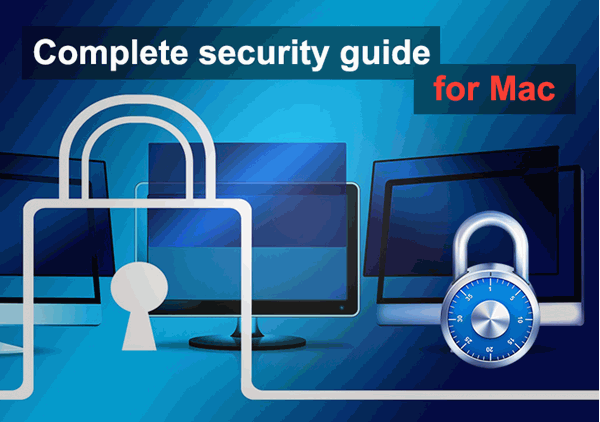7 Steps to Enhance Your Mac’s Security – Guide to Secure Mac OS
The Mac OS has a reputation for being a very secure and robust OS especially as compared to the likes of Windows. However, Mac has become very popular in recent times and the reputation of impregnability may not hold so true anymore. As such, if you own a Mac it is more critical than ever to be vigilant about your computer than ever before.
This is especially so for a new computer, where configuring the security settings can be quite a complex task with tons of activities not enabled by default or hidden behind the scenes.
With the threat of losing data to hackers for Mac users on the rise, there are three main avenues through which your computer may become vulnerable.
3 Main Avenue Through Which Your Computer May Become Vulnerable
- Via email.
- Over the internet
- From someone gaining direct access to the Mac.
However, by taking measures o harden the privacy and security of your computer, you can minimize the risk of losing data to unauthorized persons. The following are seven of the most important steps to take to protect your Mac.

7 Steps to Enhance Your Mac’s Security
- Lock down your Mac
The first and most important thing you need to do when you get your new Mac is to lock it down to prevent unauthorized access.
– Set up Passwords: If you have not set up your password, you need to set the password or if you already have a password, change it to something impossible to guess. If you normally work in a public space such as a coffee shop or a busy office you should also specify a password that one needs to enter when the computer goes into sleep mode or turns on the screensaver. The good thing about this setting is that you can also set the duration of time that has to pass after the screen saver turns on before the password is required.
– Disable automatic login: When you get your new Mac or install a new OS X, it will typically have a default user account that automatically logs in at startup. This may be perfectly safe if you only use the commuter at home but if you travel with the Mac, it poses a huge risk. With automatic login, anyone could log into your computer and have access to your files. As such, you need to change settings and confirm that the OS X asks for a password when it boots up.
- Enable the Two Way Firewall
The Mac comes with an inbuilt firewall that provides inbound and outbound protection. Given the increased threat from targeted attacks and new malware, the best defense is to have multiple layers of protection.
If by chance some malware got into your computer, the best way to prevent it from connecting to the Internet and transmitting your data to a hacker is by having outbound protection from a firewall. From an anti-malware perspective, there is perhaps nothing more important to a two-way firewall system than the outbound firewall protection. With the outbound protection enabled, it will always inform you if there is any downloaded software that is attempting to connect to the Internet when it should not be doing so.
On the other hand, the inbound firewall will prevent any installed programs and apps from receiving incoming connections from the Internet without proper authorization. By doing this you lock down access to your computer to prevent any data from leaking out.
- Patch up your Mac Regularly
Apple is always releasing performance and security patches for the Mac OS. You need to be downloading and installing all these updates to keep your Mac safe from vulnerabilities that hackers could take advantage of.
Thankfully, checking for updates and installing them on the Mac is quite easy as all you need to do is launch the Software Update Tool. As long as you have internet, the computer will check for any new patches and updates that are needed for your computer. If you do not want to be checking for the updates manually, you can set the Mac to automatically check for, download, and install the updates when they become available.
- Apply a Firmware Password
Most new Macs come with the FileVault encryption enabled by default so that the boot disk comes encrypted and impossible for anyone without the user password to access.
Nonetheless, a tech-savvy person with a USB memory stick can still wipe data from your computer by either reinstalling the macOS/OS X or by booting it from the memory stick. The best way to prevent such a scenario is by applying a firmware password.
The firmware password prompt will then be activated any time someone tries to boot the computer in Recovery Console or via a USB stick. Since you are the only one with the firmware password, your data will be relatively safe if the computer gets into the wrong hands.
Nonetheless, you need to be careful with firmware passwords and not forget them as you may just lock yourself out of the computer and have to contact Apple for assistance.
- Modify Sharing Settings
Your Mac can share files with other Macs and a whole range of other devices such as printers and Bluetooth devices. They can also share screens, and have remote login and management, all of which can open the door for the introduction of malware or the theft of data.
While most sharing and connections need a password, the window that you opened might just have a flaw that might make your Mac not as secure as you think it is. If a hacker can get a vulnerability in any of your sharing devices, you could get all manner of malware and viruses into your computer. As such, it is always advisable to disable any sharing devices that you are not using to be safe from any threats.
- Scan for Malware
While we are nowhere near the tidal wave of malware that hits Windows PCs, Mac still gets its fair share of malware. Nonetheless, with phishing attacks and platform-agnostic malware becoming more commonplace, you need to protect your computer from ever-increasing threats.
The first line of defense for a Mac is to enable the inbuilt Xprotect, a power anti-malware tool that quarantine checks any files downloaded from the internet and warns you when you intend to install potentially dangerous programs.
You can also use other antivirus software such as Bitdefender virus scanner that scans your files for any malware. The best thing about these apps is that, unlike Windows anti-malware apps, they do not slow down your system by installing system monitoring software.
It’s also recommended to install a VPN on your Mac. You can Google list of recommended Mac VPNs.
- Use Find My Mac
Unlike the other tips on the list, this one is aimed at the old school Mac thieves who prefer the grab and run. Fortunately, the Mac comes with a setting that makes it possible to locate your lost or stolen Mac using GPS, and if possible remotely lock it or wipe it to prevent unauthorized access.
All you need to do is go to System Preferences, enable the setting and you are good to go. However, this setting only works when the Mac is online. For this reason, you need to ensure that your computer has the guest user-enabled login that is not password protected. As such, whenever the Mac is lost or gets stolen, you can simply log onto icloud.com and track the exact location of the computer when the thief boots it up.




